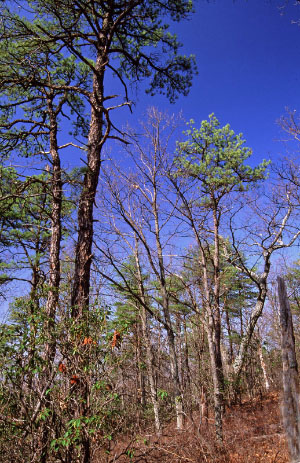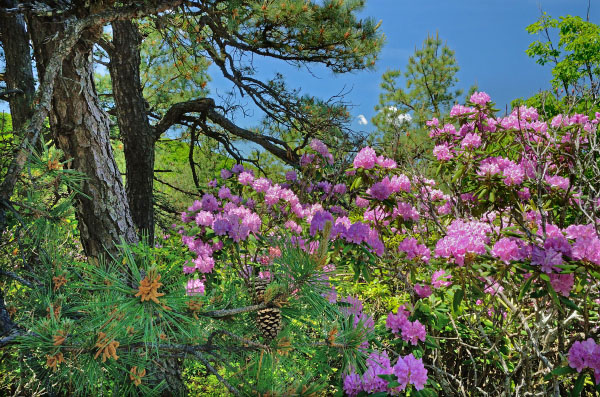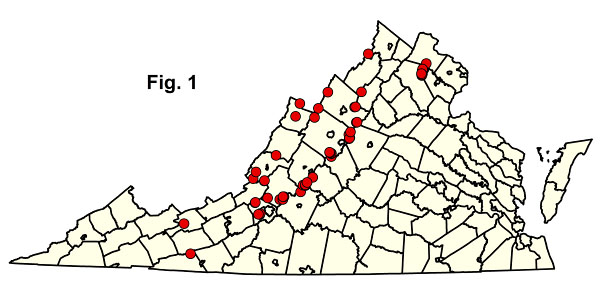
 自然保护与休闲部
自然保护与休闲部保护·守护·共享
 自然保护与休闲部
自然保护与休闲部 目录
目录松树 - 橡树 / 石楠林地
This group contains species-poor, fire-influenced, mixed woodlands of xeric, exposed montane habitats. Communities in this group occur in the Appalachians from New York south to northern Georgia. Sites are typically located on convex, south to west facets of steep spur ridges, narrow rocky crests, and cliff tops. Pine - Oak / Heath woodlands are widespread throughout both the Ridge and Valley and Blue Ridge provinces in western Virginia. They occur at elevations from below 300 m (1,000 ft) to more than 1,200 m (4,000 ft) on various substrates, but most commonly on acidic, sedimentary and metasedimentary substrates, e.g., sandstone, quartzite, and shale. A few stands occur on Piedmont monadnocks and foothills. Soils are very infertile, shallow, and droughty. Thick, poorly decomposed duff layers, along with dead wood and inflammable shrubs, contribute to a strongly fire-prone habitat. Short-statured table-mountain pine (Pinus pungens) and/or pitch pine (Pinus rigida) are usually the dominants forming an open overstory, often with co-dominant chestnut oak (Quercus montana). Less important tree associates include scarlet oak (Quercus coccinea), Virginia pine (Pinus virginiana), blackjack oak (Quercus marilandica var. marilandica) and sassafras (Sassafras albidum). Except in the Piedmont stands, bear oak (Quercus ilicifolia) is often abundant in the shrub layer, along with various ericaceous species such as mountain-laurel (Kalmia latifolia) and black huckleberry (Gaylussacia baccata). Colonial shrubs usually pre-empt available microhabitats for most herbaceous species, but eastern bracken fern (Pteridium aquilinum ssp. latiusculum) and turkeybeard (Xerophyllum asphodeloides) are often competitive enough to achieve significant cover.
周期性火灾是一个重要的生态过程,它为松树和竞争力较弱的草本植物的再生提供了机会,同时阻止了潜在的大乔橡树(尤其是栗橡树)的连续侵占。在悬崖和其他多岩石的地区,由于极端的土壤条件,植被能够自我繁衍。减少火灾和本地害虫南方松甲虫( Dendroctonus frontalis )是对该群体群落最严重的威胁,尽管从历史上看,松甲虫引起的死亡以及随后的林分更替火灾是松树再生的主要机制。全球罕见的变异莎草( Carex polymorpha )、该州罕见的北方松蛇( Pituophis melanoleucus melanoleucus )和几种稀有蛾类均以橡树为食,在当地与这些林地有关。在这些干燥、多岩石、半开放的栖息地中经常发现的更常见和显眼的动物包括北方栅栏蜥蜴( Sceloporus undulatus hyacinthinus )和五线石龙子( Eumeces fasciatus )。

北部和中部阿巴拉契亚松橡树/石楠树群落的一部分出现在暴露的、高海拔的沉积脊顶峰上,有时被称为山地或阿巴拉契亚“松树荒地”。尽管这些群落受到火灾的影响,但由于土壤极浅且耐旱,且经常受到强风和冰冻的侵袭,即使长期没有发生火灾,植被仍然保持着矮小的灌木丛(< 6米 [ 20英尺] 高)的地貌。据记载,弗吉尼亚州仅出现过一次此类“松树荒地”,位于温泉山 (巴斯县),占地约60公顷 ( 150英亩),海拔在1 , 100和1 , 200米 ( 3 , 600和4 , 000英尺) 之间。更大的例子出现在附近的西弗吉尼亚州,海拔为1 , 200至1 , 375米( 4 , 000至4 , 500英尺),位于北福克山 (彭德尔顿县) 的山顶。弗吉尼亚州的这一奇异现象以茂密的、几乎无法穿透的卡托巴杜鹃花 ( Rhododendron catawbiense )、熊橡树 ( Quercus ilicifolia )、山月桂 ( Kalmia latifolia )、黑越橘 ( Gaylussacia baccata ) 和晚矮丛蓝莓 ( Vaccinium angustifolium ) 灌木丛为特征,其中还零星分布着挺水松 ( Pinus rigida ) (但仍为灌木大小)。荒地植被的平均高度在严重烧伤后的几年内从膝盖高到约5米( 16英尺)不等。从成分和环境角度来看,阿巴拉契亚中部“松树荒地”可被视为松树 - 橡树/石楠林生态群的一部分。
参考文献:Fleming ( 2002 a)、Fleming ( 2002 b)、Fleming 和 Coulling ( 2001 )、Fleming 和 Moorhead ( 2000 )、Groeschl等人( 1992 )、Leahey 等人 ( 2006 )、Martin等人( 1982 )、Olson 和 Hupp ( 1986 )、Rawinski等人( 1994 )、Rawinski等人( 1996 )。 © DCR-DNH,加里·P·弗莱明。
© DCR-DNH,加里·P·弗莱明。
该组由73地块样本代表,主要来自弗吉尼亚州西北部和中西部(图1 )。该组的中央阿巴拉契亚林分已被广泛采样,并通过对地块数据的几项区域分析进行了稳健分类。弗吉尼亚州西南部的这种植被代表了与南阿巴拉契亚山脉植物区系具有亲缘关系的类型,但尚未得到充分采样。单击下面任何突出显示的 CEGL 代码即可查看NatureServe Explorer 提供的全球 USNVC 描述。

 下载下面列出的每个社区类型的组成汇总统计电子表格。
下载下面列出的每个社区类型的组成汇总统计电子表格。

